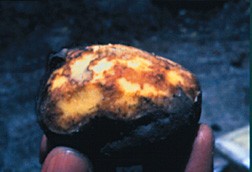Aggressive, virulent type of potato late blight threatens Russian potato production, Cornell plant pathologists say
By Blaine Friedlander
New virulent types of the potato late blight pathogen have emerged in Russia, threatening farmers and consumers with the destruction of an essential staple crop there, according to the Cornell-Eastern Europe-Mexico (CEEM) Potato Late Blight Program.
The new strains of Phytopthora infestans, better known as potato late blight, are far more aggressive than the pathogen that triggered the Irish potato famine of the 1840s, having evolved through sexual mating. Unlike the old strains, the new pathogen can survive harsh winters in the soil, further endangering crops.
"Potatoes are a sustaining food crop, the second bread for many parts of Russia. A severe late blight problem could harm millions of people and possibly destabilize the region," says W. Ronnie Coffman, the chairman of CEEM and the associate dean for research at Cornell University's New York State College of Agriculture and Life Sciences. "But that would depend on whether alternate food supplies could be moved into the affected areas in a timely manner."
Because of a drought-caused potato shortage in 1976, the Russian Federation and the nations of Eastern Europe imported the disease in shipments of 25,000 tons of potatoes from Mexico, where the late blight pathogen originated. In the 1980s the Europeans successfully battled the pathogen with fungicides, says K.V. Raman, Cornell University professor of plant breeding and the executive director of CEEM. But Russia's current harsh economic conditions make fungicides unaffordable for the nation's myriad small farm holdings.
The story of the late blight pathogen is complex. There are only two mating types of this organism, the A-1 and the A-2, both fairly short-lived on their own. The Irish potato famine, though calamitous, was caused only by the A-1 and subsided gradually during the latter 19th century with the discovery of Bordeaux mixture, the first fungicide effective against late blight. There was no A-2 mating type strain in Ireland at the time. After the famine, "only one mating
type of the late blight pathogen - the A-1 that escaped Mexico in the 1840s - was found worldwide," says William E. Fry, Cornell professor of plant pathology, whose research focuses on the late blight problem. "Sexual reproduction didn't occur then because partner mating types were found only in Mexico."
When potato tubers from Mexico arrived in Europe in 1976, some contained the A-2 strain, permitting A1 and A2 organisms to reproduce sexually and create oospores, the resting state of the pathogen. Sergey Elansky, Moscow State University assistant professor of plant pathology, who worked in Ithaca with Cornell scientists under CEEM funding, says the pathogens proliferate freely and survive in the soil despite harsh winter conditions. When warm and moist summers arrive, they attack the potatoes and destroy the harvest. Being the result of sexual reproduction, these spores can, in turn, reproduce and adapt other characteristics.
To date, a series of fungicides have been used to combat the late blight and have been fairly dependable for those farmers who can afford it. As a result, developing-world potato production has grown to 85 million tons from 30 million tons in the last 40 years, a greater rate of increase than for any other food crop.
In Russia, small farmers annually grow 3.4 million hectares (8.4 million acres) with an average yield of 10 tons per hectare. Total annual potato production is between 34 million and 39 million tons.
CEEM scientists see no quick solution. However, they are cooperating with other international agricultural organizations, such as the International Potato Center in Peru, the International Cooperative Program for Potato Late Blight in Mexico, Mlochow Research Center at the Plant Breeding and Acclimatization Institute in Poland and the Vavilov Institute for Plant Research in Russia to develop new potato varieties that resist the disease.
Research emphasis is on survival of the fittest. Researchers are crossing domestic potatoes with wild relatives from Latin America which have developed resistance naturally by co-existing with the disease for millennia. Such research usually takes about 14 years for one variety. Just in February, Cornell announced a blight-resistant variety, the New York 121, a white potato derived from Peruvian and Argentinean descent by Robert Plaisted, Cornell professor of plant breeding.
In the last 10 growing seasons, the St. Petersburg region of Russia has seen at least seven blight years, the Moscow region has seen five and Siberia has seen three blight years. The federation's Sakhalin Island, north of Hokkaido, Japan, has seen blighted potato harvests every year for the past decade.
CEEM's work in Eastern Europe is funded by the U.S. Department of Agriculture's Foreign Agricultural Service, the Wallace Genetic Foundation and the Civilian Research Development Foundation.
Media Contact
Get Cornell news delivered right to your inbox.
Subscribe